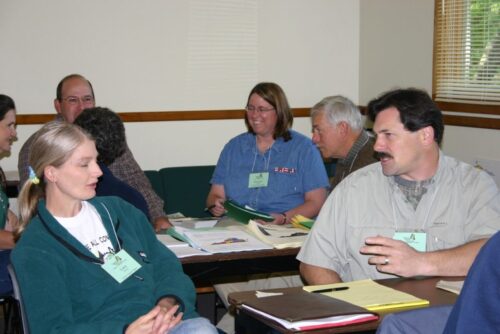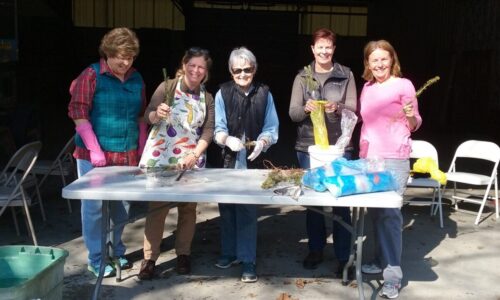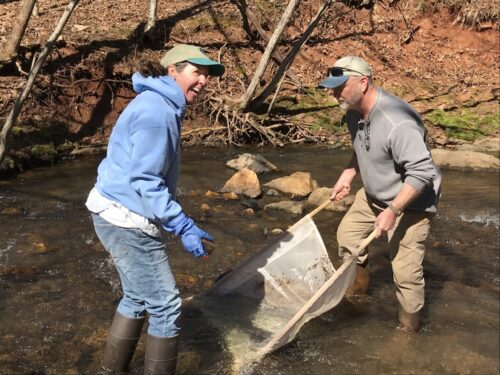A Natural Partnership
January 25, 2022 9:24 am

By Ellen Powell, DOF Conservation Education Coordinator
This is a tale of partnership, program creation, and a great idea brought to life.
Early in 2004, Dr. Jeff Kirwan of Virginia Tech heard about a new volunteer program that had taken root in several states – one with enormous potential benefit for Virginia’s natural resources. In a matter of weeks, he pulled together a group of seven motivated worker bees and sent us to a training at a rural retreat center in Missouri. Our task was to learn about a concept called the Master Naturalist program, and to come back with a way to make it work here in Virginia.
The Virginia group consisted of staff from Virginia Cooperative Extension / 4-H (I was one of those at the time) and State Parks, in addition to a couple of volunteers. Only a few of us knew each other when we arrived, but we quickly bonded over our sense that this program would be a powerful force. That wasn’t going to happen without teamwork.
We learned that week about several state models for Master Naturalist programs, and we decided that the Texas model made the most sense for Virginia. It looked a lot like the already successful Master Gardener program, in that volunteers would receive intensive training and in return, give back hours of volunteer service. When we returned from Missouri, our team began meeting, in person and by conference call, piecing together the elements of a workable program. We added other agencies that brought unique expertise: Virginia Department of Forestry (DOF), Virginia Department of Game and Inland Fisheries (now Department of Wildlife Resources), and the Virginia Museum of Natural History.
- Steering committee members meet with new chapter coordinators in 2006. (Photo by Michelle Prysby)
- Virginia’s state insect, the eastern tiger swallowtail, was chosen for the program logo.
A little over a year later, Dr. Kirwan somehow convinced 5 agency heads to kick in equal amounts of seed money that would hire a coordinator and jump start the program. In the fall of 2005, the Virginia Master Naturalist (VMN) program was official!
The first 10 VMN chapters held training classes in 2006. Today, the VMN program has 30 chapters, 7 sponsor agencies, and more than 2100 active volunteers. Master Naturalists volunteer in the areas of stewardship, education, and citizen science. You might see them out with binoculars participating in a bird count, leading a group of school children on a tree ID walk, or chopping bittersweet vines along your favorite trail.
- Historic Rivers Chapter VMNs bag seedlings for a Walk in the Forest event. (Photo by Page Hutchinson)
- Blue Ridge Foothills and Lakes Chapter VMNs collect stream macroinvertebrates to monitor water quality. (Photo by Jennifer Helms)
There is no doubt that VMNs make an impact. In 2020 alone, they logged more than 149,000 hours of volunteer service. That included contributing to more than 60 citizen science projects, improving habitat through over 400 stewardship projects, and making more than 36,000 educational contacts. As calculated by the Independent Sector, their volunteered time had a value of nearly $4.3 million that year.
Each VMN chapter has an advisor from one of the sponsoring agencies. Here at DOF, our staff advise or co-advise seven of the chapters. How does the Master Naturalist program help fulfill the DOF mission? In 2020, VMNs dedicated more than 8600 hours to projects such as collecting acorns for the DOF nursery, leading Project Learning Tree activities, assisting with American chestnut restoration, planting riparian buffers, and managing invasive plants on public lands. VMNs often use State Forests for citizen science activities and education. They have also participated in various urban and community forestry projects statewide.
Volunteering to benefit Virginia’s natural resources would be a great new year’s resolution for 2022. If you’d like to get involved, visit the VMN website to connect with your local chapter.
Tags: Conservation, Partnerships
Category: Education, Public Information



